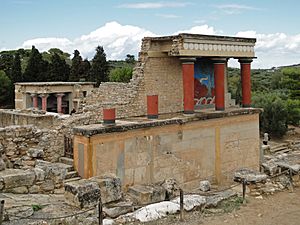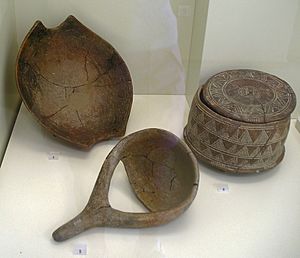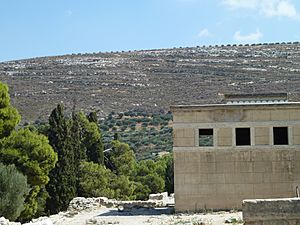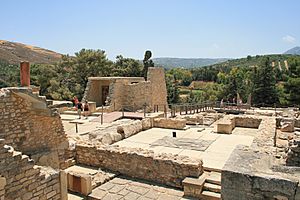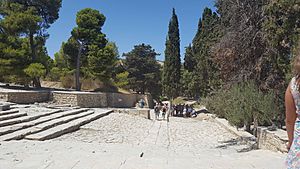Knossos facts for kids
|
Κνωσός
|
|
|
Restored North Entrance with charging bull fresco
|
|
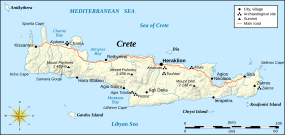
Crete, showing Heraklion, location of ancient Knōsos
|
|
| Alternative name | Cnossus |
|---|---|
| Location | Heraklion, Crete, Greece |
| Region | North central coast, 5 km (3.1 mi) southeast of Heraklion |
| Coordinates | 35°17′53″N 25°9′47″E / 35.29806°N 25.16306°E |
| Type | Palace complex, administrative centre, capital of Crete and regions within its jurisdiction |
| Length | North-south length of inhabited area is 5 km (3.1 mi) |
| Width | East–west width of inhabited area is 3 km (1.9 mi) max. |
| Area | Total inhabited area: 10 km2 (3.9 sq mi). Palace: 14,000 m2 (150,000 sq ft) |
| Height | Unknown |
| History | |
| Builder | Unknown; Daedalus according to Greek mythology |
| Founded | First settlement about 7000 BC. First palace dates to 1900 BC. |
| Abandoned | Some time in Late Minoan IIIC, 1380–1100 BC |
| Periods | Neolithic to Late Bronze Age. First palace built in the Middle Minoan IA period. |
| Cultures | Minoan, Mycenaean |
| Associated with | Middle Minoan: people of unknown ethnicity termed Minoans Late Minoan: Mycenaean Greeks |
| Site notes | |
| Excavation dates | 1900–1931 1957–1960 1969–1970 |
| Archaeologists | Initial discoverers of the palace: Arthur Evans; David George Hogarth, Director of the British School of Archaeology at Athens; Duncan Mackenzie, superintendent of excavation; Theodore Fyfe, Architect; Christian Doll, Architect For the additional work on the Neolithic starting in 1957: John Davies Evans |
| Condition | Restored and maintained for visitation. |
| Management | 23rd Ephorate of Prehistoric and Classical Antiquities |
| Public access | Yes |
Knossos (pronounced Noh-sos) is the largest ancient site from the Bronze Age on the island of Crete. Many people call it Europe's oldest city. It was once the main city of the powerful Minoan civilization.
People first settled here around 7000 BC, during the Neolithic period. The name Knossos comes from ancient Greek writings. The palace of Knossos became the most important center for ceremonies and government for the Minoan people. The palace was left empty sometime between 1380 BC and 1100 BC. No one knows exactly why, but it might have been due to a disaster.
Around 2000 BC, the city area of Knossos was home to as many as 18,000 people.
Contents
Life in the Neolithic Period
The site of Knossos has a very long history of people living there. It started with the first Neolithic settlement around 7000 BC. Many remains from this period are found across Crete. They are in caves, rock shelters, houses, and settlements. Knossos has a thick layer of Neolithic remains. This shows that many settlements existed here before the famous palace was built.
Arthur Evans, who dug up the palace in modern times, thought that Neolithic people arrived around 8000 BC. They likely came by boat from overseas. They built the first of many villages using wattle and daub (a mix of woven branches and mud). Modern dating suggests this was closer to 7000–6500 BC. Many clay and stone tools for making cloth have been found. There are also finely ground axes and mace heads made of colorful stones. These include greenstone, serpentine, diorite, and jadeite. People also used obsidian knives and arrowheads.
Many small animal and human statues were found. Evans believed these were used to worship a Neolithic mother goddess.
John Davies Evans (who was not related to Arthur Evans) did more digging at the palace site. He focused on the Neolithic layers. In the earliest Neolithic period (7000–6000 BC), a small village of 25–50 people lived where the Central Court of the palace now stands. They lived in wattle and daub huts. They raised animals and grew crops. Sometimes, they buried their children under the floor of their homes. These early villages were made up of several families living very closely together. They spent most of their time outdoors and were often nomadic.
In the Early Neolithic (6000–5000 BC), a larger village of 200–600 people grew. It covered most of the palace area and nearby slopes. People lived in one or two-room square houses. These houses had mud-brick walls on stone foundations. The inside walls were covered with mud plaster. The roofs were flat, made of mud over branches. Residents dug hearths (fireplaces) in the center of their main rooms. One unusual house under the West Court had eight rooms and covered 50 m2 (540 sq ft). Its walls were at right angles, and the door was in the middle. Large stones supported areas under more stress. The fact that there were no separate sleeping areas suggests these might have been storage units.
The settlement in the Middle Neolithic (5000–4000 BC) had 500–1000 people. Their homes were stronger and likely offered more privacy for families. The building style was similar, but windows and doors had timber frames. A fixed, raised hearth was in the center of the main room. Cabinets and beds were built along the walls. Under the palace, a large stone house called the Great House was found. It was 100 m2 (1,100 sq ft) and had five rooms with meter-thick walls. This suggests it might have had a second story. This house was probably not a private home. It might have been used by the community or for public events, perhaps as an early version of the palace. In the Late or Final Neolithic (around 4000–3000 BC), the population grew a lot.
The Minoan Period
The first palaces on Crete were built around 2000 BC. This was in the early part of the Middle Minoan period. Palaces were built at Knossos, Mallia, Phaestos, and Zakro. These palaces changed how society was organized in Crete and Greece. They were very different from the Neolithic village system that came before. Building palaces meant there was more wealth and a stronger central power. This power was likely both political and religious. Some think these palaces were inspired by models from places like Ugarit in Syria.
These early palaces were destroyed around 1700 BC. This was most likely due to earthquakes, which are common in Crete. By 1650 BC, they were rebuilt even grander. The time of these second palaces (around 1650–1450 BC) was the peak of Minoan wealth. All the palaces had large central courtyards. These might have been used for public ceremonies and shows. Living areas, storage rooms, and administrative offices were built around the courtyard. There were also workshops for skilled craftspeople.
The palace of Knossos was by far the biggest. Its main building covered three acres, and with other buildings, it was five acres. It had a grand staircase leading to important rooms upstairs. A special religious area was on the ground floor. The palace had sixteen storage rooms. The most important items in these rooms were pithoi, which were huge storage jars up to five feet tall. They were mainly used to store oil, wool, wine, and grain. Smaller, more valuable items were kept in lead-lined chests. The palace also had bathrooms, toilets, and a drainage system. A theater was found at Knossos that could hold 400 people. It was probably used for religious dances.
Building methods at Knossos were typical for the time. The foundations and lower walls were made of stone. The whole structure was built on a timber frame of beams and pillars. The main walls were made of large, unbaked bricks. The roof was flat, with a thick layer of clay over brushwood. Inside rooms were made bright by light-wells. Wooden columns, many fluted, were used for support and decoration. The rooms and hallways were decorated with frescoes. These paintings showed scenes from daily life and processions. There were very few scenes of warfare. The frescoes also showed women's fashion of the time. They had fancy hairstyles and wore long dresses with ruffled skirts and puffed sleeves.
Knossos became wealthy mainly by using Crete's own resources. These included oil, wine, and wool. Trade also played a big part. Herodotus wrote that Minos, the legendary king of Knossos, created a thalassocracy (a sea empire). Thucydides agreed, adding that Minos cleared the seas of pirates. This helped trade grow and led to the colonization of many Aegean islands. We know this is likely true because Minoan pottery has been found in many places. These include Egypt, Syria, Anatolia, Rhodes, the Cyclades, Sicily, and mainland Greece. Crete also had strong ties with Rhodes, Miletus, and Samos. Cretan influence can even be seen in the earliest writing found in Cyprus. The main market for Cretan goods was the Cyclades islands. They wanted pottery, especially stone vases. We don't know if these islands were ruled by Crete or just trading partners. But Cretan influence was definitely strong.
This was also true for mainland Greece. Both old stories and archaeological finds show strong links between Crete and Athens. The most famous legend is the Minotaur story. It says that Athens had to pay tribute to Knossos. This legend tells of a creature, half-man and half-bull, living in a labyrinth (a huge maze). Bulls are often shown on pottery and frescoes at Knossos. The palace's complex layout might have inspired the idea of a labyrinth. One common religious symbol, often seen on palace walls, is the double-headed axe called the labrys. This is a word from the Carian language for that type of tool or weapon.
Around 1450 BC, at the peak of Cretan power, the palaces at Mallia, Phaestus, and Zakro were destroyed. Smaller settlements also fell. Only Knossos remained, surviving until about 1370 BC. When it was destroyed, Greeks were living there. Their presence is shown by a new focus on weapons and war in art and burials. Mycenaean-style tombs were adopted. There was also influence from mainland pottery styles. This was confirmed when Michael Ventris decoded the Linear B tablets. He showed that the language was an early form of Greek. It was very different from the earlier Linear A writing. Sir Arthur Evans found the Linear B tablets at Knossos. He thought they were a later version of Linear A, so he called them Linear B.
Some people thought Knossos was destroyed by a volcano on Santorini. But most agree that it was destroyed by human violence. This likely happened after an invasion of Crete by Greeks from the Argolid region, probably the Mycenaeans. Knossos was still doing well when it was destroyed around 1370 BC. Trade and art were still thriving. The exact reason for its destruction is not known. But a likely reason is that the Mycenaeans, who were now powerful on the mainland, wanted to remove a rival.
Legends of Knossos
In Greek stories, King Minos lived in a palace at Knossos. He asked Daedalus to build a labyrinth, a very large maze. This maze was to hold his son, the Minotaur. Daedalus also built a special dancing floor for Queen Ariadne. The name "Knossos" was later used by Arthur Evans for the site.
William Stillman, an American consul, was the first to connect the ruins with the labyrinth legend. He saw the double axe symbol on the walls. He called the ruins "labyrinthine." Evans agreed with him. The myth of the Minotaur tells that Theseus, a prince from Athens, sailed to Crete. He was forced to fight a terrible creature called the Minotaur. The Minotaur was half-man and half-bull. King Minos, the ruler of Crete, kept it in the Labyrinth. The king's daughter, Ariadne, fell in love with Theseus. Before he went into the Labyrinth, Ariadne gave him a ball of thread. He unwound it as he went in so he could find his way back. Theseus killed the Minotaur. Then, he and Ariadne escaped from Crete, away from her angry father.
It seems the word labyrinth was indeed connected to ancient Crete. The double axe symbol was used across the Mycenaean world. It was a protective mark. Axes were carved on many stones of the palace. It also appears in pottery designs. It is a key symbol in the Shrine of the Double Axes at the palace. This symbol is found in many shrines across Crete and the Aegean. Finally, the word appears on a Knossos tablet written in Linear B. It says Daburinthoio potniai, which means "to the mistress of the Labyrinth." This tablet records giving one jar of honey. Scientists are still working to fully understand all these clues.
Knossos in Later Times
In 2015, new research showed that Knossos was very rich in imported goods during the early Iron Age. It was also nearly three times larger than earlier digs suggested. Archaeologists used to think the city declined around 1200 BC. But this new work found that the city actually thrived. It was abandoned much later.
After the Minoans fell, people returned to Knossos around 1000 BC. It stayed one of the most important centers on Crete. The city had two ports: Amnisos and Heraklion. The ancient geographer Strabo said that people from Knossos settled the city of Brundisium in Italy. In 343 BC, Knossos joined forces with Philip II of Macedon. The city hired a mercenary named Phalaikos to fight their enemy, the city of Lyttus. The Lyttians asked the Spartans for help. The Spartan king Archidamus III then fought against the Knossians.
In Hellenistic times, Knossos came under Egyptian influence. But even with military efforts during the Chremonidean War (267–261 BC), the Ptolemies could not unite the warring city-states. In the third century BC, Knossos grew its power to control almost the whole island. But during the Lyttian War in 220 BC, it was stopped by a group led by the Polyrrhenians and the Macedonian king Philip V.
Twenty years later, during the Cretan War (205–200 BC), Knossians again fought against Philip. With help from the Romans and Rhodians, they freed Crete from Macedonian influence. With Roman help, Knossos became the most important city on Crete again. But in 67 BC, the Roman Senate chose Gortys as the capital of the new province of Crete and Cyrene. In 36 BC, Knossos became a Roman colony called Colonia Iulia Nobilis. This colony was built with Roman-style architecture. It was near the palace, but only a small part of it has been dug up.
We know Knossos is the same as the Bronze Age site because of Roman coins. These coins were found scattered around the site, which was then a large mound called Kephala Hill. Many coins had "Knosion" or "Knos" on one side. The other side showed a Minotaur or Labyrinth. These coins came from the Roman settlement of Colonia Julia Nobilis Cnossus. The Romans believed they were the first to settle Knossos.
During the 9th century AD, people moved to the new town of Chandax (modern Heraklion). By the 13th century, Knossos was called Makruteikhos, meaning 'Long Wall'. Today, the name Knossos is only used for the ancient site. It is now in the growing suburbs of Heraklion.
Discovery and Modern History
The site of Knossos was first found in 1878 by Minos Kalokairinos. The main excavations at Knossos began in 1900. They were led by the British archaeologist Sir Arthur Evans (1851–1941) and his team. The digging continued for 35 years. The site was much bigger than Evans expected. He also found two ancient writing systems. He called them Linear A and Linear B. This was to tell them apart from the pictographs also found. By studying the layers of the palace, Evans developed an idea of the civilization that used it. He called it Minoan, using a name already linked to objects from the area.
Since their discovery, the ruins have been a center for archaeological digs. They are also used for education and tourism. During the two world wars, governments fighting for control of the eastern Mediterranean used the site as a headquarters.
The Palace Complex
The palace's features changed over time. What we see today is a mix of structures from many centuries. The most recent features are the most visible. So, the palace never looked exactly as it does now. Also, parts of it have been rebuilt using modern materials. This was done to protect the site from decay and heavy winter rains. After 1922, Arthur Evans, who owned the site, wanted to rebuild parts of it. He based his work on archaeological evidence. The palace might not be exactly as it was, and some parts might be quite different. But overall, it is likely a good general copy, given the effort and care taken. Opinions vary, from those who think it's mostly fantasy to those who trust Evans's work completely. Most people have an opinion somewhere in the middle.
Location of the Palace
In archaeology, the words "Knossos" and "palace" can be a bit confusing. The palace was not just a king's home. It also had rooms for a royal family. But most of the buildings were for the city's government, religion, and economy. So, "palace complex" is a better name. In ancient times, Knossos was a town that surrounded and included Kephala hill. This hill was not like a Greek acropolis (a fortified hilltop). It wasn't very high or steep, and it wasn't fortified. Other Minoan palaces were different. Phaistos, built at the same time as Knossos, was on a steep ridge. It controlled access to the Messara Plain from the sea and had walls. We don't know how warlike the Minoan civilization was. But Knossos was not like a Mycenaean fortress, either before or during Mycenaean rule.
The complex was built around a raised central court on top of Kephala hill. Older buildings were removed, and the top of the hill was leveled for the court. The court is long and narrow. Its long side points north-northeast, often called "north." Maps usually show the court horizontally, seeming to go east-west, or vertically, with north at the top. Either way, it can be confusing unless the compass directions are clearly marked. About 5 km (3.1 mi) north of the palace is the sea, at the Port of Heraklion. To the south is the Vlychia Stream. This stream flows east-west and joins the Kairatos River, which flows north-south. Kephala is a separate hill where these two streams meet.
The Kairatos River flows into the sea between the modern port of Heraklion and the airport. In ancient times, the river flowed freely. Today, it goes through Heraklion's sewers before coming out near the shore. It flows down from higher ground at Arkhanes to the south. Part of it was diverted into the Knossos Aqueduct. The water there was clean enough to drink. When it reached Knossos, it became the main drain for the sewer system of a town that may have had up to 100,000 people. Today, most people live to the north. The river still acts as a sewer, and much of its water is used for irrigation. On the opposite side of the Vlychia from Knossos is Gypsades Hill. This is where the Minoans got their gypsum (a soft mineral). Limestone was taken from the ridge to the east.
The archaeological site of Knossos refers to the palace complex. It also includes several ancient houses nearby that were dug up with the palace. South of the Vlychia is the Caravanserai. Further south are more Minoan houses. The Minoan Road crossed the Vlychia on a Minoan Bridge. It then went directly into the Stepped Portico, a covered stairway, leading to the palace complex. Near the northwest corner of the complex are the ruins of the House of the Frescoes. Across the Minoan Road from the northwest is the Arsenal. On the north side of the palace are the Customs House and the Northeast House. Further northeast is the modern village of Makrotoichos. Between it and the palace complex is the Royal Villa. On the west side is the Little Palace.
The Royal Road is what remains of an ancient Minoan road. It connected the port to the palace complex. Today, a modern road, Leoforos Knosou, follows or replaced the old path. It serves the same purpose and continues south. The excavated part of the ancient Royal Road is part of the complex. The modern road partly covers the Little Palace. Just northwest of there, off the modern road, is where Evans built Villa Ariadne. This was his home and an administrative center. The villa is on a slope overlooking the ruins. At the edge of the property, on the road, is a house that was renovated many times. It was a home for the official keeper, called the Taverna. Immediately south of the villa, over parts of the Little Palace, is the modern Stratigraphical Museum. South of the museum is a modern settlement, across from the entrance to the west court. Parking is to the north, off Leoforos Knosou. A strip of fields remains on the northwest between the palace complex and the streets of Heraklion. The east and west are protected by north-south mountain ridges. The Kairatos valley is between them.
General Features of the Palace
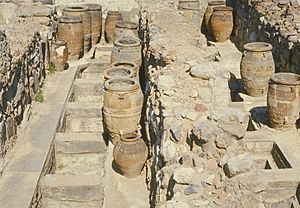
The great palace was built slowly between 1700 and 1400 BC. It was rebuilt several times after being destroyed. Older structures were on Kephala hill before it. The features we see most clearly today are mainly from the last period of people living there. Evans called this the Late Minoan period. The palace has a very interesting layout. The original design is hard to see because of all the changes made later. The 1,300 rooms are connected by hallways of different sizes and directions. This is different from other palaces of that time, which used a few main hallways. The 6 acres (24,000 m2) palace included a theater. It had a main entrance on each of its four sides. It also had many large storage rooms, called magazines. Inside these storage rooms were huge clay containers (pithoi). These held oil, grains, dried fish, beans, and olives. Many items were processed at the palace. It had mills for grain, presses for oil, and presses for wine. Under the pithoi were stone holes. These were used to store more valuable things, like gold. The palace used advanced building methods. For example, part of it was built up to five stories high.
Water Management
The palace had at least three different systems for managing water. One brought in fresh water. One drained rainwater. And one drained wastewater.
Aqueducts brought fresh water to Kephala hill. The water came from springs at Archanes, about 10 km away. These springs are the source of the Kairatos river. The aqueduct split, sending water to the palace and to the town. Water was moved around the palace by gravity. It flowed through terracotta pipes to fountains and spigots. The pipes were shaped to fit tightly together, sealed with rope. Unlike Mycenae, no hidden springs have been found here.
Wastewater was drained through a closed system. This led to a sewer away from the hill. The queen's megaron (main hall) had the first known water-flushing latrine. It was next to the bathroom. This toilet was a seat over a drain. It was flushed by pouring water from a jug. The bathtub in the bathroom also had to be filled by someone carrying and pouring heated water. It was probably drained by tipping it over into a floor drain or by scooping the water out. These special toilet and bathtub features were rare in the 1,300-room complex.
The hill often got heavy rains. So, a system to drain runoff water was needed. It started with channels on flat surfaces. These channels zigzagged and had basins to control the water's speed. The upper part of the system was probably open. Manholes gave access to the covered parts.
Ventilation
Because of its location on the hill, the palace got sea breezes in the summer. It had porticoes (covered walkways) and air shafts to help with air flow.
Minoan Columns
The palace also features the Minoan column. This column is very different from Greek columns. Greek columns are usually made of stone. Minoan columns were made from the trunk of a cypress tree. Cypress trees are common in the Mediterranean. Greek columns are thinner at the top and wider at the bottom. This makes them look taller. But Minoan columns are thinner at the bottom and wider at the top. This is because the cypress trunk was placed upside down to stop it from sprouting. The columns at the Palace of Minos were plastered and painted red. They stood on stone bases with round, pillow-like capitals (tops).
Pottery
Many pieces of pottery have been found at Knossos. They are heavily decorated and have unique styles for each time period. This pottery helps archaeologists tell the age of different layers at the site. By comparing Knossos pottery to similar pottery found elsewhere in the eastern Mediterranean, Evans created a timeline for the wider region. This timeline is very reliable. However, one problem was that careful records of where some objects were found were not always kept. This was due to the huge size of the project and the difficult conditions for the archaeologists and workers.
Frescoes
The palace at Knossos was very colorful. This was also true for Greek buildings in ancient times and today. In the Early Minoan period, walls and floors were coated with a pale red color from red ochre. Besides the background color, the walls had fresco panel murals, all in red. In the Middle Minoan period, artists added white, black, then blue, green, and yellow. The colors came from natural materials, like ground hematite. Outdoor paintings were done on fresh stucco with raised designs. Indoor paintings were done on fresh, pure plaster, which was softer than the usual wall plaster.
The decorations usually showed scenes with borders. These included humans, legendary creatures, animals, rocks, plants, and sea life. The earliest ones copied pottery designs. Most have been put back together from many small pieces found on the floor. Evans had different experts work on this, including artists, chemists, and restorers. The use of symmetry and templates helped them rebuild more than just the small pieces would allow. For example, if a small piece showed part of a design, the rest could be filled in using a template found elsewhere. Like ancient Egyptian tomb paintings, certain rules were followed. For example, male figures were shown with darker or redder skin than female figures.
Some archaeologists have argued that Evans and his restorers were not just finding the palace as it was. They believe he was creating a modern artwork based on the art and architecture of the 1920s.
The Throne Room
The most important room in the "Minoan" palace was the Throne Room. It is also called the Little Throne Room and dates to LM II. This room has an alabaster seat built into the north wall. Evans identified this as a "throne". There are gypsum benches on three sides of the room. Opposite the throne, behind the benches, is a tub-like area called a lustral basin. Evans and his team thought this was a place for religious cleaning.
You entered the room from an anteroom through double doors. The anteroom connected to the central court, which was four steps up through four doors. The anteroom also had gypsum benches. Carbonized remains between two of them might have been a wooden throne. Both rooms are in the ceremonial area on the west side of the central court.
The throne is flanked by the Griffin Fresco. It shows two griffins (mythical creatures) lying down and facing the throne, one on each side. Griffins were important mythical creatures. They also appeared on seal rings, which were used to stamp identities into soft materials like clay or wax.
The actual use of the room and the throne is not clear.
Here are the two main ideas:
- The seat of a priest-king or a queen: This is the older idea, from Evans. In this view, the Mycenaeans would have held court here. They came to power in Knossos around 1450 BC. The "lustral basin" and the room's location in a sacred area mean it was likely for a "priest-king."
- A room for a goddess to appear: In this idea, a goddess would have sat on the throne. This could have been a statue, a priestess acting as the goddess, or just in people's imagination. In this case, the griffins would be a symbol of divinity, not just a royal symbol.
The lustral basin was first thought to be for ritual washing. But because it has no drain, some experts now doubt this idea. It is now thought that the tank might have been an aquarium, or perhaps a water storage area.
Society at Knossos
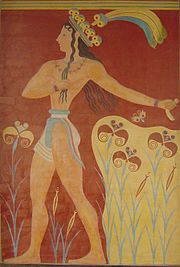
Archaeologists have long debated the main purpose of the palace. Was it a center for government, a religious center, or both? Some think it was a theocracy, where religious leaders also ruled. Another important debate is about Knossos's role in ruling Bronze Age Crete. Was it the main center, or was it equal to other palaces found on Crete? Many of these other palaces were destroyed and abandoned in the early 15th century BC. This was possibly by the Mycenaeans. But Knossos stayed in use until it was destroyed by fire about 100 years later. Knossos showed no signs of being a military site. For example, it had no fortifications or large stores of weapons.
Notable Residents
- Aenesidemus (1st century BC), a philosopher who doubted knowledge
- Chersiphron (6th century BC), an architect
- Epimenides (6th century BC), a prophet and poet-philosopher
- Ergoteles of Himera (5th century BC), an Olympic runner who lived abroad
- Metagenes (6th century BC), an architect
- Minos (mythical), father of the Minotaur
Images for kids
-
"Prince of lilies" or "Priest-king Relief", plaster relief at the end of the Corridor of Processions, restored by Gilliéron, believed by Arthur Evans to be a priest-king, wearing a crown with peacock feathers and a necklace with lilies on it, leading an unseen animal to sacrifice
See also
 In Spanish: Cnosos para niños
In Spanish: Cnosos para niños
- Magasa
- Trapeza


